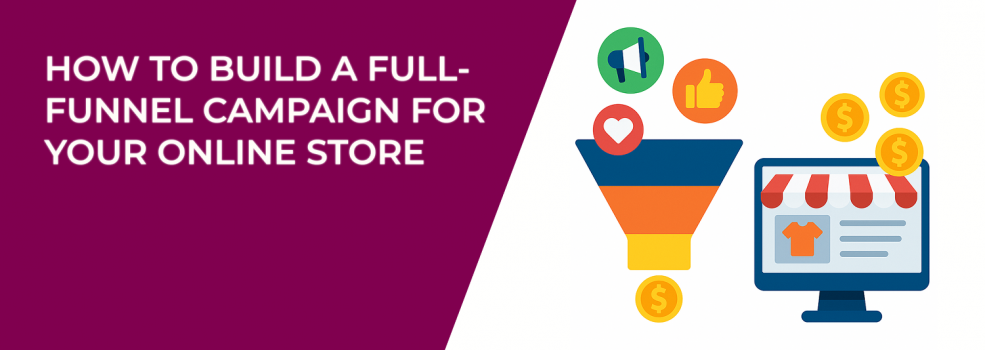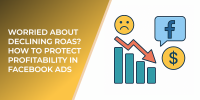If you're running paid ads for your online store and only focusing on direct sales, you're missing out on the majority of your audience’s journey. Most customers don’t buy the first time they see an ad. They observe. They evaluate. They compare. Then — when it feels right — they buy.
A full-funnel campaign recognizes that buying isn’t a straight line. It helps guide shoppers from brand discovery all the way to post-purchase loyalty. Done right, it doesn’t just increase conversions — it creates a customer experience that feels smart, seamless, and natural.
Let’s dive into exactly how to build a high-performing full-funnel ad campaign for ecommerce, stage by stage.
What Is a Full-Funnel Campaign — And Why Does It Matter?
The term "funnel" comes from classic marketing — visualizing how people move from large, unaware audiences down to a smaller group of buyers. The modern digital funnel still follows this logic, but the behaviors are far more complex.
Here’s a quick breakdown of the three primary stages:
-
Top-of-Funnel (TOFU): Grab attention and introduce your brand.
-
Middle-of-Funnel (MOFU): Educate and build interest and trust.
-
Bottom-of-Funnel (BOFU): Drive conversions with personalized, direct offers.
Add to that a post-purchase layer — where you turn one-time buyers into loyal, repeat customers — and you’ve got a strategy that’s built to scale.
Why does this structure matter? Because ads work best when they match a customer’s level of awareness. A person who’s never heard of you won’t respond well to a sales-heavy message, just like a warm lead won’t be impressed by an ad that treats them like a stranger.
Want the full technical breakdown? Explore the Facebook Ads Funnel Strategy to understand how each layer feeds the next.
Step 1: Top-of-Funnel (TOFU) — Drive Awareness and Attention
At this stage, your goal is simple: get noticed. You’re reaching people who don’t know your brand yet, so think of TOFU content as your first handshake. It's not the time to hard-sell — it's the time to build intrigue.
Recommended Campaign Settings:
-
Objective: Reach, Brand Awareness, or Video Views.
-
Ad Formats: Short-form videos, Reels, carousels, value-driven blog post promos.
-
Targeting Options:
-
Broad interest-based audiences.
-
Lookalike audiences (based on customer lists or website visitors).
-
Contextual placements on platforms like Facebook and Instagram.
-
These settings help you cast a wide but intelligent net — one that prioritizes discoverability and engagement, not conversions (yet).
What Should You Say?
Think storytelling, visual appeal, and entertainment. Showcase your brand personality and what you stand for — not just what you sell.
Here are a few ad ideas that perform well at this stage:
-
Short product demo videos with upbeat music or captions.
-
Behind-the-scenes content that humanizes your brand.
-
Blog snippets or infographics that address a pain point your ideal customer faces.
-
UGC-style visuals that blend into organic content.
All of these formats are designed to stop the scroll and generate curiosity. You’re not looking for a purchase — you’re aiming for awareness and emotional connection.
If you're unsure who to target at this stage, this guide to defining your audience will help you start strong.
Step 2: Middle-of-Funnel (MOFU) — Build Interest and Trust
Your audience now knows who you are — but they’re still weighing their options. This is your chance to go deeper, show off your value, and turn interest into intent.
Recommended Campaign Settings:
-
Objective: Traffic, Engagement, or Lead Generation.
-
Ad Formats: Testimonials, product comparisons, case studies, long-form videos.
-
Targeting Options:
-
Website visitors.
-
Social engagers (likes, comments, shares).
-
Video viewers from your TOFU campaigns.
-
Blog readers or quiz participants.
-
These settings work best when you retarget users based on actual engagement. You're no longer guessing — you're refining.
MOFU Content That Converts:
This stage is your chance to differentiate. That means more details, more relevance, and more emotional connection.
Some specific content formats that work well:
-
Customer testimonials that highlight transformation or satisfaction.
-
Before-and-after visuals of your product in use.
-
Buying guides or “Which product is right for you?” quizzes.
-
Case studies or influencer reviews with social proof.
-
Email lead magnets, like styling or gift guides.
These formats give your brand depth. They answer questions and remove doubts. They make people feel like they’re buying smart — not impulsively.
Still not sure how to warm up your audience efficiently? Facebook Ad Targeting 101 breaks down how to engage users based on their behavior, not just demographics.
Step 3: Bottom-of-Funnel (BOFU) — Convert Warm Leads into Customers
Now you’re talking to hot prospects — people who’ve visited your product pages, signed up for emails, or even added items to their cart. It’s time to help them take the final step.
Recommended Campaign Settings:
-
Objective: Conversions, Sales, or Catalog Sales.
-
Ad Formats:
-
Dynamic Product Ads (DPA).
-
Retargeting carousels or single-image ads.
-
Testimonials paired with CTAs.
-
These campaigns are laser-focused — personalized, timely, and driven by data.
Targeting Options:
Focus on high-intent audiences:
-
Users who added to cart but didn’t buy.
-
People who browsed your product or checkout pages.
-
Past purchasers (for upsells).
-
Engaged email subscribers.
At this point, your messaging needs to resolve last-minute objections — pricing, urgency, or perceived risk.
Here’s what typically works well:
-
Time-limited offers like "24-hour flash sale."
-
Free shipping thresholds to increase AOV.
-
Money-back guarantees that reduce risk.
-
Cart abandonment ads with personalized reminders.
-
Product reviews or ratings embedded into creatives.
If your BOFU campaigns are falling flat, this guide on fixing non-converting ads will help you spot creative or structural issues.
And if you haven’t set up retargeting yet? Stop what you're doing and read this step-by-step retargeting guide.
Step 4: Post-Purchase — Turn Buyers Into Brand Advocates
Your customer converted — but don’t stop there. This is where repeat purchases, referrals, and loyalty begin.
Post-Purchase Campaign Ideas:
-
Email flows that offer order confirmation, product care tips, or surprise coupons.
-
Retargeting ads for upsells or complementary items.
-
Loyalty and referral incentives tied to purchase history.
-
Review collection campaigns to build future social proof.
These efforts extend your customer lifetime value and turn one-time buyers into superfans. Don’t leave post-purchase marketing on autopilot — this is one of the most profitable layers of your funnel.
How to Connect the Funnel Stages Effectively
Even the best campaigns fail when stages operate in silos. Your funnel should function like a relay — passing audiences smoothly from stage to stage with tailored messaging and pacing.
Here’s how to keep everything flowing:
-
Segment audiences based on funnel behaviors
Set up custom audiences based on video views, site activity, and cart behavior — then serve them ads that match their level of engagement. -
Map creatives to funnel intent
Don’t reuse the same creative across stages. Someone who’s never heard of you needs a different message than someone who’s abandoned their cart. -
Monitor conversion paths, not just CTR
Track the full journey — from view to click to purchase. Use this data to spot weak points and fix them fast. -
Time your retargeting windows
Let TOFU and MOFU campaigns breathe before layering on conversion ads. Rushing can tank ROAS and overwhelm your audience. -
Set up strong tracking infrastructure
Without accurate Meta Pixel and event tracking, your entire funnel will operate on guesswork. Don’t let a missing event kill your attribution.
Wrapping Up
A well-structured full-funnel campaign is more than a best practice — it’s your growth engine. It aligns your message with where your audience is mentally and emotionally.
Instead of relying on hacks or one-hit offers, you build a system. A brand. A scalable customer acquisition strategy.
Ask yourself:
-
Are your campaigns walking customers through a journey — or just shouting offers?
-
Do your creatives match intent at every stage?
-
And are you using performance data to shape next steps?
When every stage connects with purpose and precision, your funnel doesn't just convert — it compounds.

